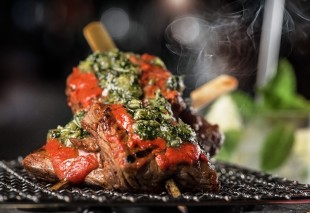

Cuisine Focus: Japanese

How popular is Japanese cuisine in the Middle East and why?
Jomar Reyes, head chef, Sho Cho: Japanese cuisine is definitely a huge trend in the Middle East, from casual outlets serving sushi to fine dining Japanese such as Zuma. People love to embrace the elegance of flavours and techniques.
Gohei Kishi, group executive chef, Ramusake: It is very popular everywhere in the world; I believe it is because of the simplicity of the dishes.
Hugh Sato Gardiner, head chef, Okku: Japanese cuisine has been hugely popular particularly in Dubai for a number of years. The light, fresh, healthy approach to Japanese cuisine sits extremely well with both the local and expat population. Japanese cuisine is also based around a concept of sharing which is a traditional way of dining in the region.
Francis Salva, F&B manager, Inakaya Abu Dhabi: I think the biggest factor which makes the cuisine famous is the Japanese’s reputation in terms of work ethic. They put pride in their work. Japan holds the record for the most Michelin-starred restaurants in the world.
Glenn Lacandalo, executive chef, Sumo Sushi and Bento, Dubai: It’s become increasingly popular. Four years ago we had less than 20 competitors, we now have 57 brands serving Japanese cuisine on their menu.
What is the latest trend in Japanese cuisine?
Reyes: Japanese fusion has been a trend for some time but doesn’t seem like one that is slowing down anytime soon. What we try to do at Sho Cho is offer our guests delicious Japanese dishes that aren’t too challenging — from platters of sushi and tempura to share with friends over drinks on our al fresco terrace to fresh fish dishes perfect for a casual weekend lunch.
Lacandalo: Fusion, hands-down is the latest trend. Those who love traditional sushi can still get it although customers are demanding more. They want fresh and healthy options as well as combined flavours in unique and different ways.
Erick F H Oshiro, head chef, Ají: The new trend is the interpretation of Japanese cuisine according to each chef. The chef adapts and creates his/her own style.
Gardiner: Whilst I think people like the traditional approach to Japanese cuisine it is also increasingly popular to pair it with flavours and ingredients from other parts of the world. The introduction of truffle and foie gras, when used in the right context and right balance can be incredibly complementary to more traditional offerings.
What challenges do you face, if any, when it comes to Japanese cuisine?
Kishi: A misconception of the dining style. For example Ramusake is an izakaya restaurant where you order as you go along instead of ordering all at once and expecting to have starter main course and side dishes. The customer needs to be educated on dining etiquettes in order to get a better experience.
Reyes: One of the motivations behind the menu at Sho Cho was to demystify Japanese cuisine. We wanted to create a restaurant that anyone could enjoy — from families to millennials — and simply eat delicious food whilst enjoying a beverage or two and great music. With the wealth of new Japanese restaurants opening all the time, our challenge is to keep our guests coming. One of the ways we tackle this is by maintaining high standards, meaning customers come for their favourite dishes such as rock shrimp every week
Oshiro: Our challenge is educating our customers on the menu, which might include dishes that they might not have heard of before and ingredients they are not familiar with. There are still a lot of people think that Japanese cuisine is all about raw specialities like sashimi/sushi and just tempuras. Little do they know that the options are more varied than they think.
Lacandalo: Challenges for us in this arena are keeping to our core values of quality, simplicity, creativity and integrity and not just jumping on any new flashy trend without ensuring it follows the Sumo way.
What is the supply stream like?
Oshiro: Sourcing the very best ingredients can be a challenge, particularly high quality fresh fish for our sashimi, nigiri, ceviche and tiraditos. We work with the best products, we use local fish products as well as a lot of Japanese seafood, fish like a high quality of tuna, hamachi, fruits and vegetables from France. I trust that we will be able to get quality and variety of products throughout the season.
Gardiner: The supply stream is good and constantly improving. That said we have developed exceptional relationships with colleagues in Japan who assist us in getting fresh products direct from the markets there. The vast majority of the product is imported but through local partners.
Salva: There are lots of supply channels available these days. Though most ingredients are shipped from Japan, local sources are also used without compromising quality.
Lacandalo: Our supply stream is excellent as we’ve secured long-standing relationships with quality vendors in the market both in imported and local. Our new sustainable and responsibly sourced tuna is shipped in daily, fresh, never frozen and every branch in the UAE, except Al Murooj, is hand delivered.
Kishi: Being new in Dubai, I still rely heavily on imported products but I am looking to source much more local produce as some interesting ingredients are grown here. One item I am playing with lately is the pomegranate and date molasses which gives a complex flavour when substituting sugar.